Smashed at the Weekend #8
cook The Four Horsemen, drink festive cocktails, listen to Intoxicating History, watch chef Paul Liebrandt and win Virtuous Vodka
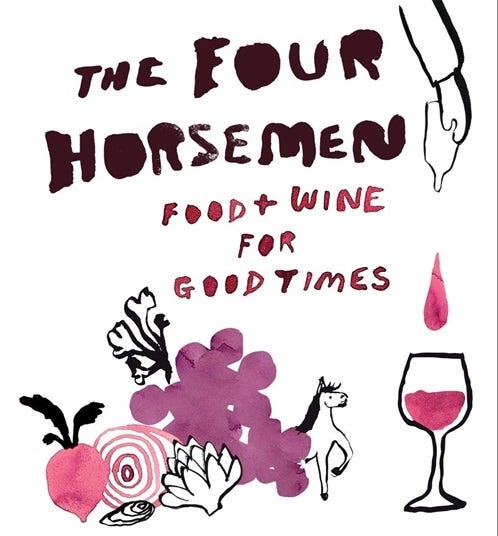


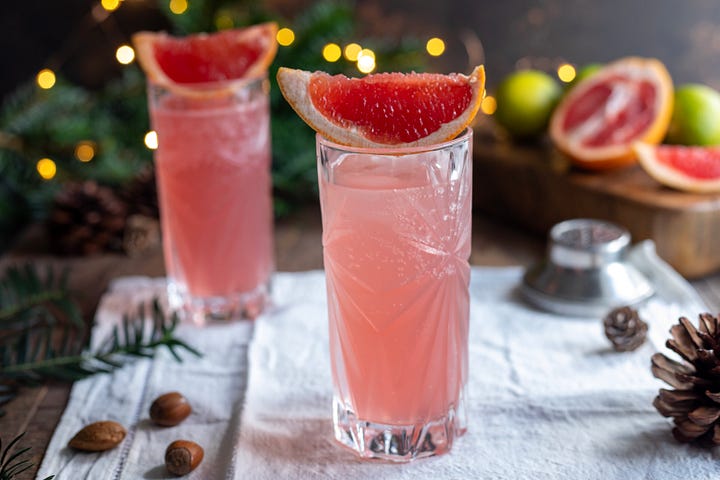
Something to cook
Recipes from The Four Horsemen
Indie rockstar opens wine bar in Brooklyn. That sounds like a recipe for disaster doesn’t it it? Said rockstar is bound to be cosplaying a hospitality professional, seduced into the role because they’re so into food and wine that everyone says they really must open their own restaurant. Then they realise how much hard work it is, get bored and go back to messing about with modular synths.
James Murphy of LCD Soundsystem opened The Four Horsemen in Williamsburg in 2015. Nearly a decade and one Michelin star later, the restaurant is still going strong, featuring at number 17 in the latest New York Times 100 Best Restaurants list. It seems he wasn’t playing around after all.
Murphy has written what he calls an ‘endless introduction essay’ to the restaurant’s excellent new cookbook. It’s actually a fascinating tale of the trials and tribulations (see what I did there?) of opening the restaurant endured by Murphy, his three fellow ‘Horsemen’ and business partners Christina Topsøe, Randy Moon and natural wine expert Justin Chearno (who sadly passed away in October this year before the publication of the book), head chef Nick Curtola and general manager Amanda McMillan.
Renovating the former site of vegan junk food emporium Foodswings took Murphy and his team over a year, including digging out the cellar, which looks, from the photos in the book, like it could have collapsed in on them at any moment. That wasn’t the only danger the Horsemen encountered, there was also ‘The Wrath of Chang’. On discovering Murphy’s plan to open a restaurant, his friend and renowned New York chef and restaurateur David Chang screamed at him: ‘Do you know where the fucking grease trap is?? Do you even know WHAT a fucking grease trap IS?? Do you know what to do when human shit is pouring out of the clogged toilet in your bathroom and into your dining room?!?!?’. Ah, the romance of restaurant life.
In addition to Murprhy’s introduction, there are notes from the late Chearno who was a pivotal figure in championing the natural wine movement in America that might make you look at those wines, and drinking wine in general, in a new light. A short essay from McMillan titled ‘Get some candles’ sheds light on matters front of house and Curtola’s autobiographical piece ‘Who is this guy’ charts his culinary journey to Brooklyn. All of that before you even get to the food.
This is a book you’ll want to read and Curtola writes engagingly about ‘Ingredients to keep close by’ (his pantry picks basically), kitchen tools, how a dish makes it on to The Four Horsemen’s menu and other topics including the importance of salt and black pepper. But you’ll also want to get the book into your kitchen and start cooking through the book’s 100 recipes.
The extracted recipes below give some sense of the very broad range of culinary references that Curtola draws on to create his distinctive style of food. You can open the book at random and find something delicious that you probably haven’t thought of making before. How about butter beans with kimchi and salt cod or grape-nuts semi-freddo with miso caramel? I’m planning to serve Curtola’s version of salmoriglio, a green sauce made with parsley, oregano, red wine vinegar-macerated shallots, Calabrian chillies (my new favourite ingredient), anchovies, lemon and garlic with absolutely everything.
When I buy a restaurant cookbook, it’s not just for the recipes (although in this case, if it was just the recipes, it would be worth having) I want to understand the place itself and get to know the people that make it what it is. The Four Horsemen delivers that in spades. It’s nothing less than an instant classic of the genre.
The Recipes
Chicken karaage with yuzu kosho aioli
Izakayas in Japan serve these bites of remarkable fried chicken with bracingly cold draft beer, and often with a hit of the chile pepper seasoning blend shichimi togarashi for heat. We serve this karaage with a citrusy and rich yuzo kosho aioli. For extra credit, you can add refreshing lettuce wraps and Kewpie mayo. Stick with thighs. They have more fat and flavor, and will crisp up better.
SERVES 4
1 pound 9 ounces (710 g) skin-on boneless chicken thighs, cut into 2-inch (5 cm) pieces
½ teaspoon grated peeled fresh ginger (use a Microplane), including any juice
1 teaspoon grated garlic (use a Microplane)
¼ cup (60 ml) soy sauce
1½ tablespoons sake
1 generous teaspoon toasted sesame oil
1 teaspoon sugar
2 quarts (2 L) canola oil, for frying
1 cup (130 g) all-purpose flour
1 cup (145 g) potato starch
2 teaspoons kosher salt
½ cup (60 ml) Yuzu Kosho Aioli (see recipe below)
Place the chicken thighs in a shallow baking dish. Add the ginger and any juice, garlic, soy sauce, sake, sesame oil, and sugar and massage the chicken lightly to combine the marinade. Cover and refrigerate for 2 hours.
In a heavy Dutch oven or deep stockpot, heat the canola oil over medium-low heat until the temperature reaches 350°F (175°C). Adjust your burner as needed to maintain that temperature as you proceed with the recipe. Have a spider handy and set a sheet tray lined with paper towels nearby.
Place the flour and potato starch in a mixing bowl and whisk to combine. Remove the chicken from the fridge and dip a few pieces at a time in the flour mix to coat, setting them on a plate or a small sheet tray as you go.
One piece at a time, place the coated chicken in the oil and fry until golden brown, 3 to 4 minutes. Remove them with the spider and transfer to the paper towel–lined tray. Season with the salt, then transfer to a serving dish. Serve with yuzu kosho aioli for dipping.
Yuzu kosho aioli
Yuzu kosho, a citrusy, spicy Japanese fermented chile condiment, sings with the richness of aioli. This makes a great dip for the Chicken Karaage, but it’s also so fun on sandwiches, grilled fish, and vegetables such as asparagus, cucumbers, and wax beans. It is a stalwart of Four Horsemen family meals for this reason.
MAKES 2 CUPS (480 ML)
2 cups (480 ml) Aioli (see below)
1¼ tablespoons yuzu kosho, plus more if needed
Add the aioli to a mixing bowl and, using a rubber spatula, stir in the yuzu kosho. Taste and adjust to your liking, then add a few drops of water, if needed, to achieve your desired consistency. Make sure to serve the same day it is made.
Aioli
Any of our cooks will tell you that I’m adamant about the freshness of the garlic in an aioli. It’s just so important: It should be added the day of use. If not, it tends to become unpleasantly astringent at an exponential rate. We grate the garlic with a fine Microplane to disperse it evenly. Beyond that, we add water, a few drops at a time, to gain the desired consistency. You generally want to avoid a “bouncy” aioli, meaning one that’s so firm it has difficulty coating whatever is dipped into it (like our Patatas Bravas, page 87). I like it a little tighter if it’s going in something brothy and a little looser if it’s going to be a dip.
MAKES 2 CUPS (480 ML)
2 cups (480 ml) Mayonnaise (see below)
1 large clove garlic, plus more if needed
Put the mayonnaise in a mixing bowl. Using a Microplane, grate the garlic (you should have around 1½ teaspoons) and then stir into the mayo to combine. Taste and adjust to your liking, then add a few drops of water to thin out the aioli to your desired consistency. Make sure to serve it the same day it is made.
Mayonnaise
Emulsifying a sauce can be a bit tricky at first, but I’ve found a few ways to make the process go smoothly. A key factor is keeping everything quite cold: Higher temperatures mean there’s a greater chance of separating, so we refrigerate everything but the salt about an hour ahead of time. Another helpful move is using a food processor—and keeping the machine cold, too, by buzzing up some ice before you begin. Of course, you can also make the mayonnaise by hand with a whisk. Just make sure to chill your bowl in the fridge at the outset. And that you have a strong arm.
MAKES 2 CUPS (480 ML)
5 large egg yolks (70 g)
2 teaspoons red wine vinegar
1 teaspoon kosher salt
1⅔ cups (405 ml) canola oil
In a food processor, combine 1 tablespoon water, the egg yolks, vinegar, and salt and buzz until smooth. With the food processor running, in a slow and steady stream, begin adding the oil to the egg yolk mix. Once the emulsion starts to thicken, you can begin to incorporate the oil a bit faster. When all the oil is incorporated, pack up the mayo into an airtight container and store it in the fridge. It should keep for about a week.
Cider-glazed pork chops with parsley salad
I’ve always had a soft spot for the parsley salads served at St. John in London. I remember watching Anthony Bourdain visit Fergus Henderson on A Cook’s Tour in the early 2000s. I was fascinated and inspired by Henderson’s simple and straightforward cooking. It was honest and, at the same time, thoughtful and precisely British. I finally found a home for a pile of dressed parsley when we put a cider-glazed pork chop on the menu one winter. The chop was first brined, then charred on a grill and brushed with a vinegar-based glaze. The sweetness from the glaze and the smoky fat didn’t need much. I ended up bringing out the great parsley salad. Note:
For a cleaner, less spicy onion flavor, you can shock your onions in an ice bath for about 3 minutes, then transfer them to a sheet tray lined with a towel to dry.
SERVES 4
FOR THE PORK CHOP:
3 bone-in pork chops, (around 10 ounces / 280 g each)
1 batch A Simple Brine for Meat and Fish (see below)
FOR THE CIDER GLAZE:
1¾ cups packed (400 g) dark brown sugar
1 cup (240 ml) cider vinegar
2 tablespoons fish sauce
1 teaspoon ground cinnamon
1 tablespoon smoked paprika
FOR THE PARSLEY SALAD:
4 cups (40 g) loosely packed fresh parsley leaves (leave on the small and tender stems) ½ cup (30 g) sliced red onion (see Note)
2 teaspoons red wine vinegar
1 teaspoon extra-virgin olive oil
Pinch Maldon salt, plus more to finish the dish
BRINE THE PORK: Put the pork chops in a deep container and pour the brine over the chops, making sure they are completely submerged. Let the pork chops brine for 3 hours in the fridge.
MAKE THE CIDER GLAZE: In a wide-bottomed saucepot, combine the brown sugar, vinegar, fish sauce, cinnamon, and paprika and bring to a boil. Reduce the heat to low and simmer for 30 minutes. Let cool.
GRILL THE PORK: Remove the pork from the brine and rinse well with cold water. Blot dry with a towel, then leave the pork chops out to continue drying. (You want the pork to be at room temperature before grilling.)
Meanwhile, prepare a charcoal grill for medium heat and have a sheet pan with a resting rack on top of it right near the grill. Warm 1 cup (240 ml) of the cider glaze in small pot. (You will have extra that can be reserved for another use.)
Once your grill is going, start your pork chops with the fat side down so you can begin to render the fat. I like to lean them against one another and use long tongs to keep them upright. If they flare up, don’t panic. Simply remove them to the tray and let the grill calm down a bit, then proceed. Once you have some color on the fat, flip them onto their sides and grill them, flipping every minute or so until you get a nice golden color on both sides, about 8 to 10 minutes.
Using a pastry brush, begin to glaze the pork, flipping frequently during the process. Be mindful that the sugar in the cider glaze will cause the pork to burn very quickly. The pork will be done when it has a deep caramelized color and the internal temperature reaches about 145°F (63°C). This should only take about 8 to 10 minutes. If the chops are getting dark and the temperature isn’t quite there, you can finish them in a 300°F (150°C) oven. You can always remove the chops to your rack throughout the grilling process to take their temperature if that’s easier than hovering your hand (and the thermometer) over a hot grill.
THE PARSLEY SALAD: In a mixing bowl, combine the parsley and onion. Dress your salad with the vinegar, olive oil, and Maldon salt. Taste and adjust.
TO FINISH: Slice the pork off the bone and cut the meat against the grain into ½-inch-thick (12 mm) slices. Season the pork with Maldon salt and divide among plates. Plate your salad next to the pork and serve
A simple brine for meat and fish
This is our universal brine. We use it for almost everything at the restaurant: chicken legs, pork chops, whole quail, fish, and much more. You can make a larger batch than called for here and store it in the fridge for a few months. Since you always want your brine to be cold when you’re submerging meats and fish, it’s helpful to have some on hand, chilled and ready to use, so you don’t find yourself having to boil and cool a batch when you need it in a pinch.
Make sure whatever ingredient you’re brining is fully submerged in the liquid. At home, I’ll sometimes use a plate to weigh down larger ingredients like pork shoulder.
I don’t really bother with aromatics in brine—I’m more concerned with seasoning. You can feel free to experiment, though, by adding spices, herbs, and vegetables to the liquid when it’s coming up to a boil. (Just note that if you add any of these to the brine, they’ll deteriorate, and the brine won’t keep as long in the fridge.) Rosemary and garlic are great with pork; black peppercorns, parsley, and bay leaves are nice with chicken. Like I said, we use it for almost everything. It’s a pretty flexible recipe.
For fish, a quick brine is sufficient: 3 to 5 minutes for fish in the ½-inch thick (12 mm) range and 10 to 12 minutes for anything thicker. Meats can be brined longer: Pork chops, for example, can be brined for anywhere from 3 to 6 hours. Whole chickens, even longer. Recipes in this book that call for brining meat will usually indicate the brining time.
Note: Don’t reuse brine—discard it after removing whatever you’ve used it for. It has animal proteins and can spoil.
MAKES 8 CUPS (2 L)
⅔ cup packed (150 g) light brown sugar
⅔ cup (150 g) kosher salt
In a pot, combine 8 cups (2 L) water, the brown sugar, and the salt and bring to a boil. Turn off the heat and allow the brine to cool. Store in an airtight container in the fridge for up to 2 months.
Bucatini with toasted garlic, chile flakes, colatura, and egg yolk
Somewhere between a decadent carbonara and a sharp aglio, olio, e peperoncino (pasta with garlic, oil, and chile), this dish comes alive with colatura di alici, an Italian fish sauce (the name translates to “anchovy drippings”). Cooking the garlic and chile flakes calls for a light touch, because you want the aromas to bloom, not burn. Later on, when it’s time to add the eggs, take extra care that the yolks don’t scramble as you coat the noodles with the sauce, which can happen if the heat is too high and there isn’t enough sauce. A little pasta water should help. It’ll also give the whole thing a lovely glaze.
SERVES 4
1 pound (455 g) bucatini
3 tablespoons kosher salt
¼ cup (60 ml) extra-virgin olive oil
½ cup (53 g) thinly sliced garlic
1 tablespoon chile flakes
⅔ cup (155 g) unsalted butter, cut into ½-inch (13 mm) cubes
2 cups (50 g) finely grated Parmigiano Reggiano cheese (use a Microplane)
2 tablespoons colatura di alici or other fish sauce
8 large egg yolks (120 g total), whisked quickly with a fork 2 cups
(60 g) loosely packed fresh parsley leaves
Fill a large pot with 4 quarts (4 L) water and add the salt. Bring the water to a boil. Add the pasta and cook for 2 minutes less than the manufacturer’s instructions indicate. You’re aiming for a bit of that al dente chew, leaving wiggle room for the pasta to cook a bit more in the sauce.
While the pasta is cooking, heat a large skillet over medium-low heat. Add the olive oil, followed by the garlic. Let it sizzle gently until aromatic, about 3 minutes. Don’t let the garlic get any color; we’re just looking to infuse the oil with flavor and soften the garlic. Add the chile flakes, then turn off the heat and ladle in 1¼ cups (300 ml) of the pasta water to stop the cooking. Add half the butter and swirl it to melt and combine.
Drain the pasta, reserving about 1 cup (240 ml) of the pasta water, then add the pasta to the pan with the garlic, chile flakes, and butter. Return the heat to medium-low and add the remaining butter. Cook, stirring often with tongs, until the pasta is nice and glazed, then add the Parm and turn off the heat. Stir to combine.
Add the colatura, then add the egg yolks and stir continuously, allowing the residual heat of the pasta to cook the egg just until it binds the sauce. Be careful not to scramble the eggs. When it’s ready, the pasta should be shiny and look very luxurious. Add the parsley, stir, and serve immediately.
Recipes extract taken from: The Four Horsemen – Food + Wine for Good Times by Nick Curtola with Gabe Ulla (Abrams, £30.00) Out now.
Photographs © 2024 David Malosh
Use the following affiliate link to buy the book and support Smashed: click here
Something to listen to
Intoxicating History podcast
In the second episode of this new upbeat and entertaining history-meets-booze podcast from the producers of The Wine Show and fronted by Henry Jeffreys (award-winning author) and Tom Parker Bowles (critic, writer, son of the Queen), you’ll discover that Charles Dickens was obsessed with pubs. There are 400 London hostelries alone mentioned in his work and Jeffreys describes The Pickwick Papers as ‘a pub crawl’.
You’ll also find out Dickens’s great-grandson Cedric was ‘an enthusiastic drinker’ and that his cure for jet lag was a bottle of champagne before boarding and then a quarter bottle on the hour every hour to be sipped medicinally while walking up and down the alleyway. Sounds like the ideal way to get arrested when you touch down.
As the podcast’s sponsor is Taylor’s Port, you won’t be surprised to learn that episode one was dedicated to the subject of Portugal’s famous fortified wine. Future episodes with cover everything from drink in James Bond to whether the English really invented sparkling wine. If the early episodes are anything to go by, it should be a series to raise a toast to.
Intoxicating History
Something to drink (and win) - Christmas cocktails
Blackberry Sake Gimlet
Makes one cocktail
100 ml Samurai Sake
30 ml Elderflower Liqueur
1 tbsp Lime
1 sprig Rosemary
3 Blackberries
To Garnish
2 Blackberries
1 sprig Rosemary
Instructions
Muddle three blackberries with a sprig of rosemary in a cocktail shaker.
Add Samurai Sake, elderflower liqueur, lime and ice, then shake until well combined.
Strain into a gimlet glass and garnish with the final two blackberries speared with a sprig of rosemary.
Cranberry Sour
Makes 1 cocktail
50 ml Virtuous Organic Rye Vodka
15 ml Lemon Juice
30 ml Cranberry Juice
1 tsp Simple Syrup
1 Egg White (or Aquafaba)
To Garnish
Dried Cranberries
Instructions
Dry shake all ingredients until well combined.
Add ice and stir to cool.
Strain into a glass and garnish with dried cranberries.
Figgy Fizz
Makes one cocktail
40ml Hernö Gin
20ml Cointreau
20ml Lemon juice
1 tbsp Fig Jam
20ml Soda
60ml Prosecco
Method: Shake all the ingredients apart from the soda and prosecco in a cocktail shaker with ice. Strain into a wine glass filled with ice and then top with the soda and prosecco.
Glass: Wine glass
Garnish: Orange peel
Subscriber competition - win a bottle of Virtuous Vodka
Virtuous Spirits have kindly offered to send a bottle of their Virtuous Vodka Rye to one lucky Smashed subscriber. The responsible Swedish beverage company established by chef Claes Stenmark in 2013 describes the unfiltered and naturally macerated vodka as ‘full-bodied and smooth, with distinct brown bread flavours, black pepper rye spice, faint vanilla and fruity sweetness’. Virtuous Vodka Rye was awarded 99 out of 100 points at the IWSC 2023 and won the Spirit Gold Outstanding 2023 award and Vodka Trophy 2023.
To Enter: if you are not a subscriber to Smashed already, click the button below and sign up to any of the subscription options including free, then click on the ‘Message Andy Lynes’ button before midday on Sunday 15 December and send me your name and email address, mentioning Virtuous Vodka. I will choose a winner at random and a representative of Virtuos Vodka will be in touch to arrange delivery of your prize. Good luck.
Something to watch
Paul Liebrandt The Creative Mind of a Michelin-Starred Chef
An interesting 45-minute interview with London-raised, New York-based chef Paul Liebrandt who won two Michelin stars at Corton restaurant in 2009 and was the youngest chef at 24 to receive a three-star review from the New York Times (their highest accolade is 4 stars). He was profiled in the 2011 documentary A Matter of Taste (available to rent on YouTube), a film that arguably prefigured the format of Chef’s Table that first aired in 2015.
Now a consultant chef who also stages pop-ups around the globe, Liebrandt talks all too briefly about his experiences working for Marco Pierre White and Pierre Gagnaire in the 90s but is more expansive on the subject of creativity and why Instagram is killing it (even though he has an Instagram account @paulliebrandt, which is worth checking out, his food is stunning) and other topics including leading a team.





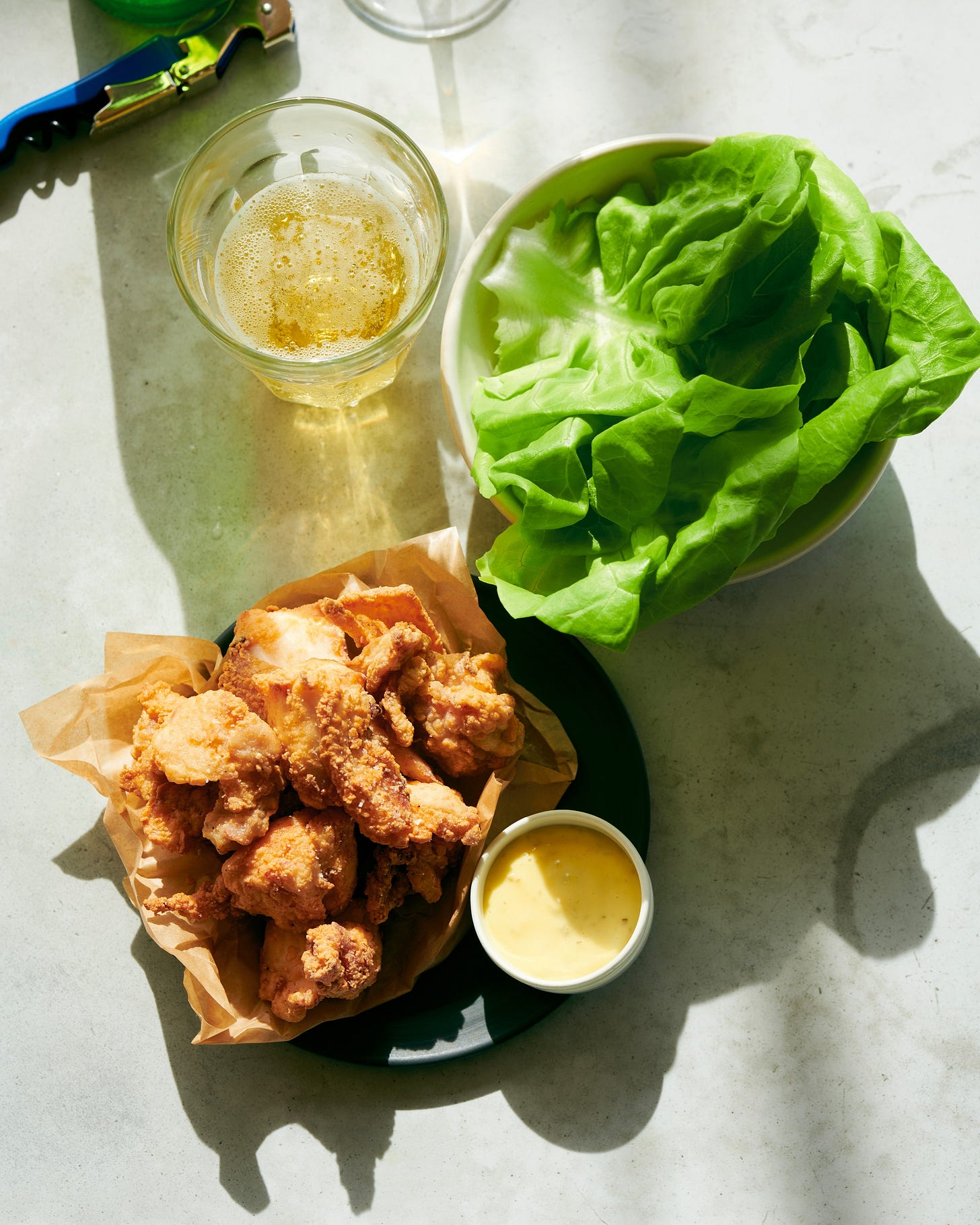


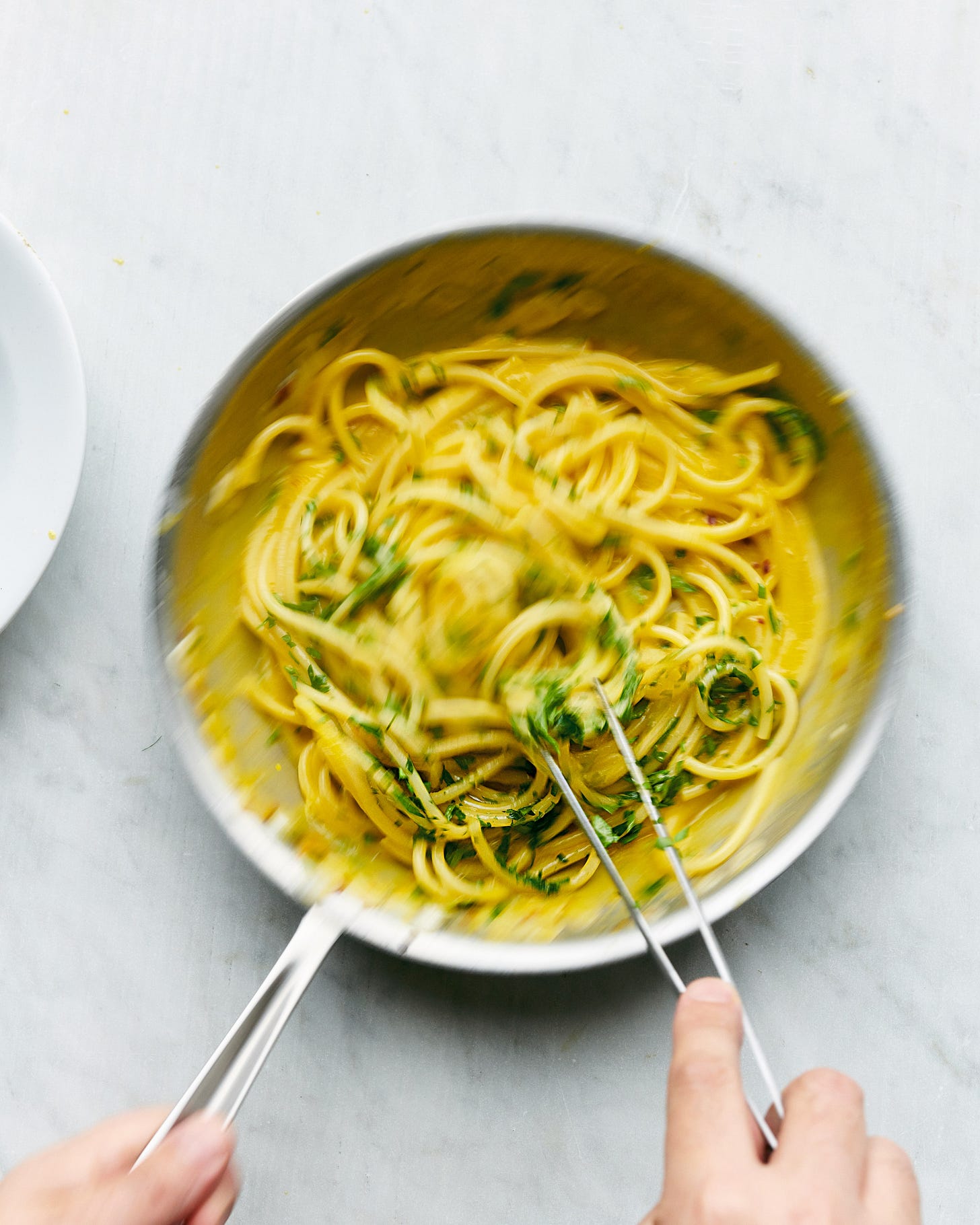





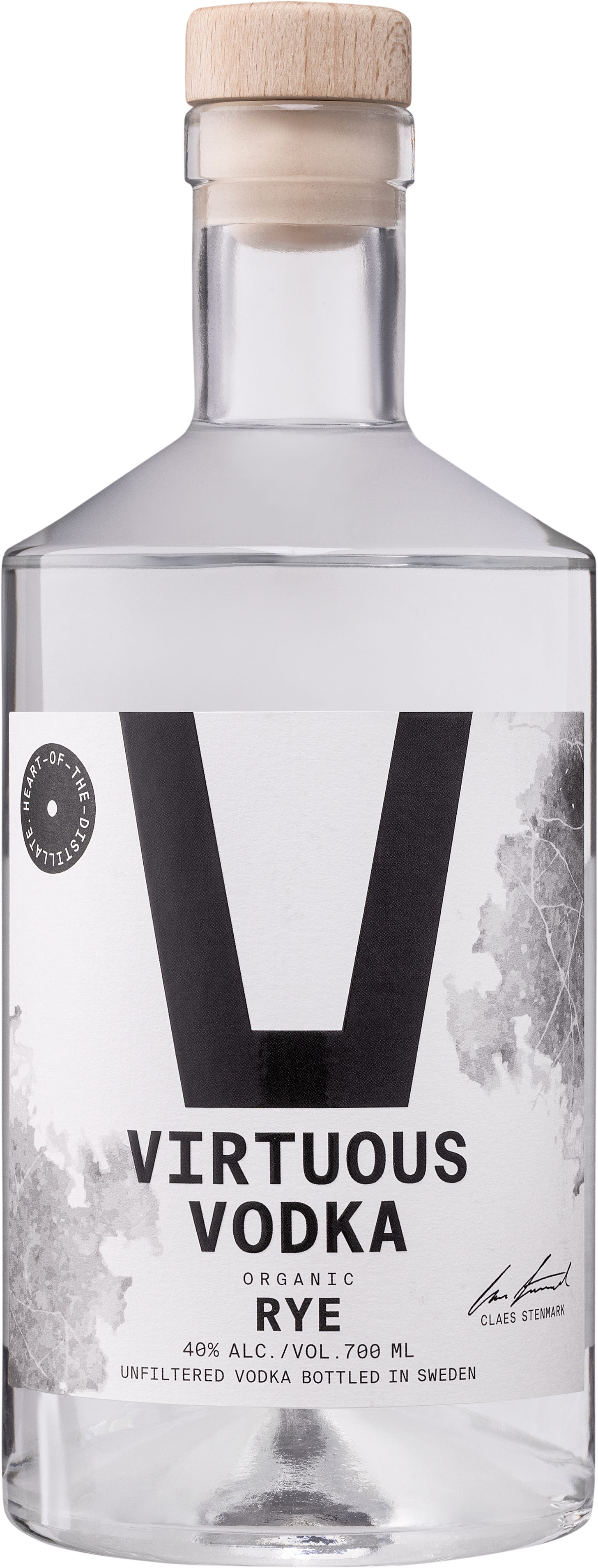
Son of the Queen??! Wow!